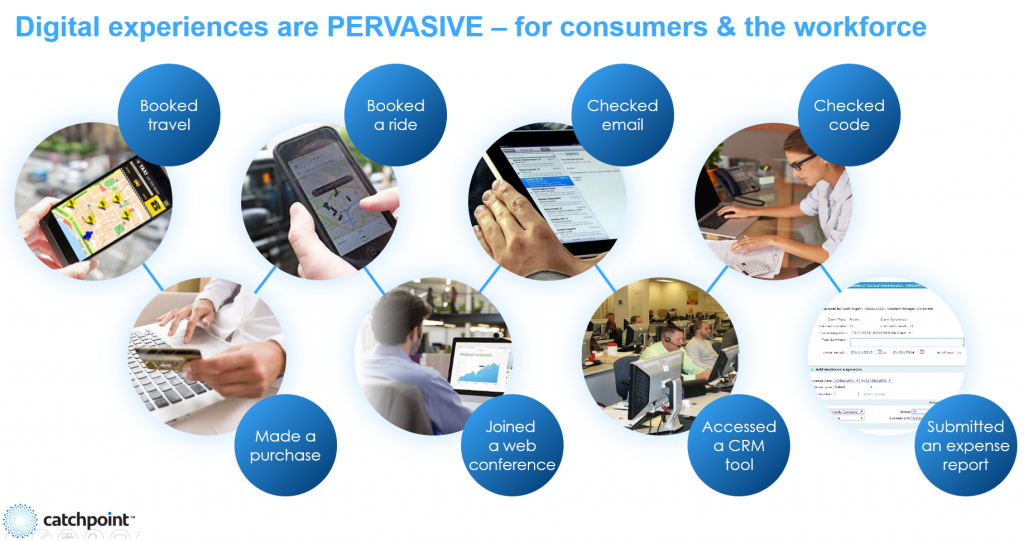Event in Review: Networking Field Day 23
At the Networking Field Day we spoke about the importance of network monitoring and the shift in enterprises’ strategic initiatives supporting UX monitoring.
Recently, Catchpoint participated in the virtual Networking Field Day. As a presenting sponsor, we spoke about the importance of network monitoring and the shift in enterprises’ strategic initiatives supporting user experience monitoring. For an hour, the discussion focused on how the digital experiences for employees and customers are converging. Enterprises are shifting to measure and monitor the tenets of reachability, availability, performance, and reliability.
Introducing Catchpoint to the Experts
Unlike most events, Networking Field Day is different. During your session, you are presenting to a delegate panel. This panel consists of network practitioners who have extensive knowledge of the topic being presented. It is an opportunity for a technology vendor like Catchpoint to share insights around our domain and provide a look into our platform. It is interactive and organic, making it interesting and less scripted.
While the first part of the session was more of an introduction to Catchpoint and digital experience monitoring, the premise was around how DevOps, NetOps, and even SecOps are aligning with the user. Regardless of who the user is, what service they are attempting to access, or what action they are trying to perform, assuring a successful experience requires observing every step. This means going beyond the corporate edge.

Data Transformation in Transition
The impact of the Covid-19 pandemic is far from complete, it is changing how businesses deploy their data transformation initiatives. While most enterprises have been transforming how they manage and use data, the initiatives focused on these efforts have either been turned upside-down or accelerated based on the industry they serve.
The pandemic has increased the reliance on online connectivity and collaboration. Uninterrupted and fast access to online services for both consumer use and corporate employee needs has put the application delivery chain to task.
Observability has never been more important. The global workforce has shifted to a more distributed environment and this has made the service delivery chain more complex since you are no longer relying on the corporate network. Employee experience is now similar to customer experience in how services are accessed and used. The use of multiple connected devices to perform both personal and business-related transactions has further blurred the definition of customer and employee experience.

During the presentation, the audience was asked, “How many connected devices do you own?” Because of users’ growing dependencies on multiple connected devices, the expectations for quality continuity of service is high. The proliferation of these devices also creates an almost infinite number of third-party services, infrastructures, and tools which expand the application delivery chain and adds to the complexity of an already inconsistent Internet. This is a challenge because any perceived latency in the user experience has a high risk of being blamed on the application or the service being accessed.
Improving Employee Experience
As more organizations allow for a more distributed or remote workforce, there is a need for consistent application availability. There are multiple ways to assure availability:
- Move critical applications closer to the employee location. This requires an increase in reliance on third-party services and applications and can require significant investment to rearchitecting the corporate IT infrastructure.
- Increase bandwidth. Increasing your bandwidth and obtaining a higher service level agreement can improve performance, however, this is dependent on what is available at each remote location, and the associated costs can be high.
- Deploying an employee experience monitoring service. Since the shift from corporate offices to remote locations is becoming a business necessity, complete visibility into the application delivery chain is crucial. What was once managed through the corporate network is now more complex and dependent on non-corporate assets, services, and network connectivity.
Employee experience monitoring is the most complete way to assure employee availability of applications and the ability to continue to work remotely.
Focusing on the Customer’s experience
Most enterprises relying heavily on the internet to provide services to their customers, the customer experience can have a direct impact on their ability to gain and retain customers. A lot happens behind the scenes when a customer clicks or interacts with an application. The multiple complex components of an application are a potential visibility gap. These gaps reduce the ability to understand the infrastructure health making it difficult to assess the true end-user experience.
As user dependency on connected devices increases, it is expected that the service accessibility and end-user experience will remain uniform across devices and networks. This demand from consumers exacerbates the already inconsistent Internet and makes it vital to keep monitoring and optimizing the application.
For network experts, a massive visibility gap continues to exist as traditional monitoring tools focus only on the infrastructure and services that the organization directly owns and controls. These tools do not account for conditions beyond the corporate network including third-party services, and therefore ignore the end user’s perspective. Network teams must take an outside-in approach and monitor from the customer to the business. It is the only way to assure a good customer experience.
Catchpoint in Action
We closed our discussion with the network delegate panel by walking through Catchpoint’s four pillars of observability – reachability, availability, performance, and reliability. We then provided a demonstration of the Catchpoint’s network insights offering showing how we help network operations teams monitor and optimize the end-user experience. We also discussed important use cases for BGP, DNS, Endpoint, and Traceroute monitoring capabilities.
The more we move from the edge and outward in the delivery chain, the bigger the challenge to see and even control performance outcomes. A solution like Catchpoint is designed around removing these visibility barriers to ensure a high performing end-user experience.
View the sessions in their entirety, here.


